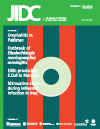Drug resistance, serotypes, and phylogenetic groups among uropathogenic Escherichia coli including O25-ST131 in Mexico City
DOI:
https://doi.org/10.3855/jidc.1703Keywords:
urinary infection, uropathogenic Escherichia coli, O25-ST131, multidrug-resistanceAbstract
Introduction: The increasing prevalence of uropathogenic Escherichia coli (UPEC) strains resistant to multiple antibiotics complicates the treatment of urinary tract infections (UTIs). This study aimed to analyze the antimicrobial resistance, serotypes, and phylogenetic groups among strains of E. coli isolated from outpatients with UTIs in Mexico City.
Methodology: A total of 119 E. coli isolates were recovered from urine samples from outpatients with clinical diagnosis of uncomplicated UTIs from 2004 to 2007. The serotype was assessed by agglutination in microtiter plates; susceptibility to antimicrobials was determined by the disk diffusion method. Clone O25-ST131 and phylogenetic groups of E. coli strains were tested by methods based on PCR multiplex.
Results: The predominant serotype was O25:H4 (21.2%). Resistance to antibiotics was ampicillin (83.7%); piperacillin (53.8%); the fluoroquinolone group (55.5-60.6%), and trimethoprim/sulfamethoxazole (TMP/SMX) (56.4%). Additionally, 36 (30.2%) isolates were multidrug-resistant and 13 of these 36 strains were identified as E. coli O25-ST131 clone by an allele-specific PCR-based assay. Phylogenetic analysis showed that 15 of 17 isolates with serotype O25:H4 belonged to group B2.
Conclusions: This is the first report that establishes the presence in Mexico of the O25-ST131 clonal group of E. coli, which has been associated with multidrug-resistance and with high virulence potential. The spread of this clone in Mexico should be monitored closely. We found a correlation between serotype O25:H4 and multidrug resistance in UPEC strains. Our results indicate that the use of ampicillin, fluoroquinolones, and TMP/SMX should be reviewed when selecting empirical therapy for UTIs.
Downloads
Published
How to Cite
Issue
Section
License
Authors who publish with this journal agree to the following terms:
- Authors retain copyright and grant the journal right of first publication with the work simultaneously licensed under a Creative Commons Attribution License that allows others to share the work with an acknowledgement of the work's authorship and initial publication in this journal.
- Authors are able to enter into separate, additional contractual arrangements for the non-exclusive distribution of the journal's published version of the work (e.g., post it to an institutional repository or publish it in a book), with an acknowledgement of its initial publication in this journal.
- Authors are permitted and encouraged to post their work online (e.g., in institutional repositories or on their website) prior to and during the submission process, as it can lead to productive exchanges, as well as earlier and greater citation of published work (See The Effect of Open Access).








